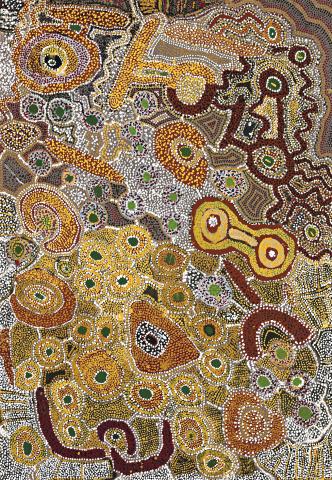WARTUNUMA, 1990
WIMMITJI TJAPANGARTI
synthetic polymer paint on canvas
119.0 x 85.0 cm
bears inscription verso: artist’s name, size and Warlayirti Artists cat. 85/90
Warlayirti Artists, Balgo Hills
Gallery Gabrielle Pizzi, Melbourne
Sotheby’s Australia, Melbourne, 29 June 1998, lot 209
The Collection of Colin and Elizabeth Laverty, Sydney
This work is accompanied by a certificate of authenticity from Warlayirti Artists, Balgo Hills
Wimmitji Tjapangarti’s artistic output in the public domain focussed on his ancestrally bestowed country around Wantjanmurra east of the Canning Stock Route. One of the first Balgo artists to paint consistently for the public domain, Wimmitji modelled his paintings on designs found in ceremonial ground mosaics, body paintings and the decoration of ritual objects. He also preferred to restrict his palette to the traditional colours of red and yellow pigments, black and white, despite the fact that a broad range of colours was made available to the artists in 1988. Nonetheless, on occasion Wimmitji experimented with colour, as in this painting that features dabs of green at the centre of roundels representing claypans.
In ancestral times, an Old Tingari Man traversed this land searching of water and food by digging holes that transformed into the claypans that cover the country today. The painting also depicts objects associated with the ancestor; boomerangs rendered in red beneath a layer of black dotting, and a carrying dish as a red arc with yellow dots in the lower register of the painting. The ancestor eventually came to rest at Wartunuma rockhole that appears as a red arc with yellow dots around a green circle in the centre of the upper register.
Wimmitji was a deeply traditional man who avoided long-term contact with the original Catholic Pallottine mission that was established in Balgo Hills in 1942 until he was in his mid-thirties, despite the fact the mission lay close to his traditional lands. He eventually joined his relatives at Balgo in 1959 and went on to become one of the most influential Kukatja elders and artists of his generation. At Balgo, he assisted in the compilation of the Kukatja-English dictionary and was a main source of information for the anthropologists Ronald and Catherine Berndt. His work featured in the first major exhibition of Balgo art, Aboriginal Art from the Great Sandy Desert, at the Art Gallery of Western Australia in 1986. Wimmitji married Eubena Nampitjin in the 1970s and theirs was to become one of the great artistic partnerships in the history of twentieth century Aboriginal art. Although undocumented, the areas of regular dotted parallel forms in the top right of the painting seem to be by a hand other than Wimmitji’s, most probably that of Eubena.
WALLY CARUANA
